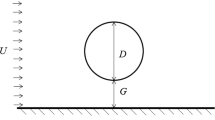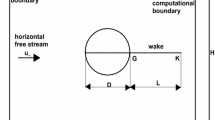Summary
The analysis of the symmetrical and the asymmetrical calender presented here for Newtonian as well as for non-Newtonian fluids leads to the following conclusions:
-
a)
Calculating roll-separating forces, it is necessary to account for the non-Newtonian flow behavior of “real” fluids. Neglecting elastic properties of “real” fluids, it can be shown, that the shear-thinning effect is leading to decreasing values of the local pressure and the roll-separating forces respectively.
-
b)
The specific power consumption decreases considerably with increasing asymmetry of the calender (increasingµ). If the exit situationβ* and the geometry of the calender are given,e is minimal for the caseε = 1.
Zusammenfassung
Aus der Analyse der Strömung newtonscher und nicht-newtonscher Flüssigkeiten im symmetrischen und im asymmetrischen Walzenspalt ist folgendes zu schließen:
-
a)
Bei der Berechnung der Walzentrennkräfte ist eine Berücksichtigung des nicht-newtonschen Fließverhaltens „realer“ Flüssigkeiten erforderlich. Es kann gezeigt werden, daß (bei Vernachlässigung der elastischen Eigenschaften) der Einfluß der Strukturviskosität ein Abnehmen der lokalen Druckwerte bzw. der Walzentrennkraft bedingt.
-
b)
Der spezifische Energieumsatz geht bei zunehmender geometrischer Asymmetrie beträchtlich zurück. Bei gegebener Walzengeometrie und konstanter Abgangssituation erreicht der spez. Energieumsatz ein Minimum beiε = 1.
Similar content being viewed by others
Abbreviations
- a :
-
half the distance between the poles
- a i :
-
coefficients of eq. [11]
- e :
-
specific power consumption
- F :
-
roll-separating force
- g ij :
-
component of the metric tensor
- h :
-
variable defined by eq. [6]
- h*:
-
h atβ = β*
- H :
-
roll separation at the nip
- K :
-
variable defined by eq. [3], used in eqs. [1] and [2]
- p :
-
pressure
- p′ :
-
pressure gradient —∂p/∂β
- Q :
-
volume flow rate
- R 1, R2 :
-
radii of the rolls
- v 1, v2 :
-
surface velocities of the rolls
- v α, vβ :
-
velocity components into theα undβ-direction respectively
- W :
-
dissipated energy
- α, β :
-
bipolar coordinates
- α 1, α2 :
-
values ofα at the wall of the rolls
- β 0 :
-
entrance coordinate
- β*:
-
exit coordinate
- δ :
-
structural parameter defined by eq. [19]
- ε :
-
surface velocity ratio
- η :
-
non-Newtonian viscosity
- η 0 :
-
zero shear rate viscosity
- η ∞ :
-
viscosity at very high shear rates
- µ :
-
radius ratio
- v :
-
dimensionless gap width
- τ :
-
shear stress
- τ W1, τW2 :
-
shear stress at the wall of the rolls
References
Perlberg, S. E. ANTEC8, 14–4 (p. 1–6) (1962).
Takserman-Krozer, R., G. Schenkel, G. Ehrmann Rheol. Acta14, 1066–1076 (1975).
Author information
Authors and Affiliations
Additional information
With 12 figures
Rights and permissions
About this article
Cite this article
Ehrmann, G., Takserman-Krozer, R. & Schenkel, G. Non-Newtonian fluid flow between rotating cylinders. Rheol Acta 16, 240–247 (1977). https://doi.org/10.1007/BF01523734
Received:
Issue Date:
DOI: https://doi.org/10.1007/BF01523734




